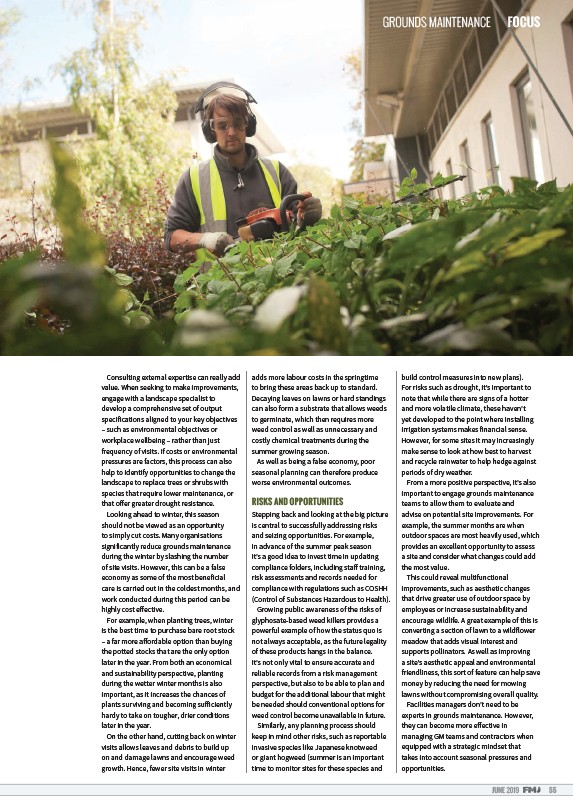
GROUNDS MAINTENANCE FOCUS
JUNE 2019 55
Consulting external expertise can really add
value. When seeking to make improvements,
engage with a landscape specialist to
develop a comprehensive set of output
specifications aligned to your key objectives
– such as environmental objectives or
workplace wellbeing – rather than just
frequency of visits. If costs or environmental
pressures are factors, this process can also
help to identify opportunities to change the
landscape to replace trees or shrubs with
species that require lower maintenance, or
that o er greater drought resistance.
Looking ahead to winter, this season
should not be viewed as an opportunity
to simply cut costs. Many organisations
significantly reduce grounds maintenance
during the winter by slashing the number
of site visits. However, this can be a false
economy as some of the most beneficial
care is carried out in the coldest months, and
work conducted during this period can be
highly cost e ective.
For example, when planting trees, winter
is the best time to purchase bare root stock
– a far more a ordable option than buying
the potted stocks that are the only option
later in the year. From both an economical
and sustainability perspective, planting
during the wetter winter months is also
important, as it increases the chances of
plants surviving and becoming su iciently
hardy to take on tougher, drier conditions
later in the year.
On the other hand, cutting back on winter
visits allows leaves and debris to build up
on and damage lawns and encourage weed
growth. Hence, fewer site visits in winter
adds more labour costs in the springtime
to bring these areas back up to standard.
Decaying leaves on lawns or hard standings
can also form a substrate that allows weeds
to germinate, which then requires more
weed control as well as unnecessary and
costly chemical treatments during the
summer growing season.
As well as being a false economy, poor
seasonal planning can therefore produce
worse environmental outcomes.
RISKS AND OPPORTUNITIES
Stepping back and looking at the big picture
is central to successfully addressing risks
and seizing opportunities. For example,
in advance of the summer peak season
it’s a good idea to invest time in updating
compliance folders, including sta training,
risk assessments and records needed for
compliance with regulations such as COSHH
(Control of Substances Hazardous to Health).
Growing public awareness of the risks of
glyphosate-based weed killers provides a
powerful example of how the status quo is
not always acceptable, as the future legality
of these products hangs in the balance.
It’s not only vital to ensure accurate and
reliable records from a risk management
perspective, but also to be able to plan and
budget for the additional labour that might
be needed should conventional options for
weed control become unavailable in future.
Similarly, any planning process should
keep in mind other risks, such as reportable
invasive species like Japanese knotweed
or giant hogweed (summer is an important
time to monitor sites for these species and
build control measures into new plans).
For risks such as drought, it’s important to
note that while there are signs of a hotter
and more volatile climate, these haven’t
yet developed to the point where installing
irrigation systems makes financial sense.
However, for some sites it may increasingly
make sense to look at how best to harvest
and recycle rainwater to help hedge against
periods of dry weather.
From a more positive perspective, it’s also
important to engage grounds maintenance
teams to allow them to evaluate and
advise on potential site improvements. For
example, the summer months are when
outdoor spaces are most heavily used, which
provides an excellent opportunity to assess
a site and consider what changes could add
the most value.
This could reveal multifunctional
improvements, such as aesthetic changes
that drive greater use of outdoor space by
employees or increase sustainability and
encourage wildlife. A great example of this is
converting a section of lawn to a wildflower
meadow that adds visual interest and
supports pollinators. As well as improving
a site’s aesthetic appeal and environmental
friendliness, this sort of feature can help save
money by reducing the need for mowing
lawns without compromising overall quality.
Facilities managers don’t need to be
experts in grounds maintenance. However,
they can become more e ective in
managing GM teams and contractors when
equipped with a strategic mindset that
takes into account seasonal pressures and
opportunities.